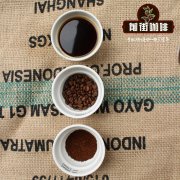What are the Indian coffee companies? what is the principle of Indian coffee monsoon treatment?

Professional coffee knowledge exchange more coffee bean information please follow the coffee workshop (Wechat official account cafe_style)
Current situation of coffee cultivation in India
Today's Indian coffee has 2 mobiles and 3 is robusta beans, and Arabica beans are less than 1 gamble 3. Karnataka in the south-west is India's main coffee-producing region, accounting for half of production; Kerlala in the south mainly grows robusta, accounting for 30 per cent of production; in the south-east, Tamilnadu is both, accounting for only 10 per cent; and the rest is scattered in emerging areas in the north.
The unique monsoon treatment method in India
The unique monsoon treatment of wind-soaked beans in Malaba in southwestern India is also a major feature of Indian coffee. The way to deal with it is that during the May and June monsoon season, people spread the coffee in a special house open around, which is about 12cm to 20cm thick for five days, and rake the beans again and again. So that all the coffee beans are exposed to the extremely humid air at that time, and then they are loosely packed in bags and piled up so that the monsoon can blow through the bags.
The bags are reloaded and piled once a week for seven weeks until the coffee beans change color and taste. Finally, the coffee beans are hand-selected, remove those not affected by the "monsoon", and then bagged for export.
The coffee produced by this process does not taste like coffee, but like wheat tea or spicy coffee, with pale bean color, good consistency and no sour taste, obvious nutty and woody flavor, is very suitable for espresso formula and is very popular with coffee lovers in northern Europe and Italy. Friends who like pure flavor may not be acceptable.
In the 19th century, in 1896, with the opening of the Suez Canal, the sea voyage time between India and Europe, but surprisingly, Indian coffee orders also sharply reduced, the reason for European customers: Indian coffee has gone sour, not only lost its strong nutty flavor, but also disappeared the charming golden yellow of the past. Indian coffee exporters scratched their heads and finally thought of the reason. The development of the shipping industry has cut the shipping time of coffee beans to Europe by more than half. The beans have already arrived at the port of destination before they have time to change, and naturally they have lost their original flavor.
Since then, after repeated experiments, Indians have finally found a way to recreate the "monsoon coffee". They built a special wind-stained plant facing west in order to catch the salty monsoon blowing from the southwest. Workers spread sunny coffee beans in the wind-soaked field, the windows are all open, and the wind stains are returned to the bag to a certain extent, but the coffee beans should not be filled too full, and the coffee bags should not be piled too dense to avoid mildew, and it is time-consuming and labor-consuming to pour out coffee beans and change sacks from time to time to avoid mold.
The weathering period is about 12 to 16 weeks, and after it is ripe, it has to be fumigated to drive out the weevil, and finally the beans are screened manually to pick out the failed beans that have not turned golden. After three to four months of wind stains, the volume of green coffee beans expanded by one to two times, the weight and density decreased, the moisture content was about 13%, and the quality and quantity changed significantly. As a result, although there is no bumpy experience at sea, the flavor of the coffee treated by the monsoon is similar to that of the previous coffee, and finally won back the hearts of European customers.
END
Important Notice :
前街咖啡 FrontStreet Coffee has moved to new addredd:
FrontStreet Coffee Address: 315,Donghua East Road,GuangZhou
Tel:020 38364473
- Prev

Does India produce coffee? what is the origin of Indian coffee beans? what are the flavor and characteristics?
Professional coffee knowledge exchange more coffee bean information Please pay attention to the coffee workshop (Wechat official account cafe_style) in fact, India is rich in coffee beans, about 250000 people in the country grow this economic product, coffee is suitable for growing in a warm environment, between the Tropic of Cancer is called the coffee belt (coffee zone), but for fear of high temperature destroying the characteristics of beans, it is mostly planted in
- Next

Do you know anything about Chinese coffee history?| How much coffee is consumed in China?
Professional coffee knowledge exchange More coffee bean information Please pay attention to coffee workshop (Weixin Official Accounts cafe_style) When the French built the railway from Hanoi, Vietnam to China in the 1880s, they brought their favorite cafes to China. Coffee has been in the Chinese market for more than a century. Today, the ubiquitous cafes on the streets have become a place where people talk
Related
- Beginners will see the "Coffee pull flower" guide!
- What is the difference between ice blog purified milk and ordinary milk coffee?
- Why is the Philippines the largest producer of crops in Liberia?
- For coffee extraction, should the fine powder be retained?
- How does extracted espresso fill pressed powder? How much strength does it take to press the powder?
- How to make jasmine cold extract coffee? Is the jasmine + latte good?
- Will this little toy really make the coffee taste better? How does Lily Drip affect coffee extraction?
- Will the action of slapping the filter cup also affect coffee extraction?
- What's the difference between powder-to-water ratio and powder-to-liquid ratio?
- What is the Ethiopian local species? What does it have to do with Heirloom native species?

